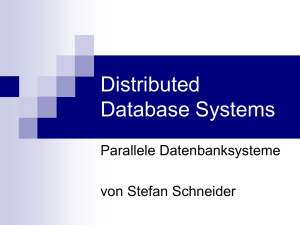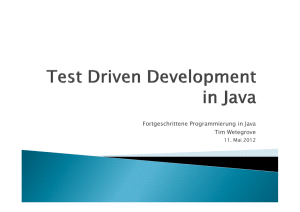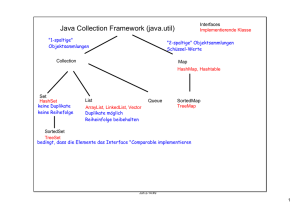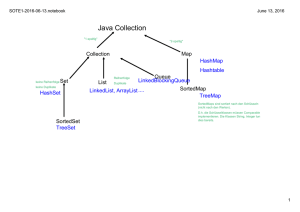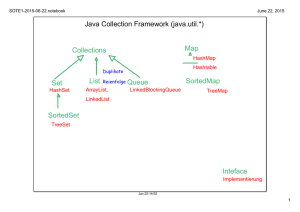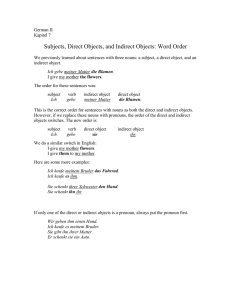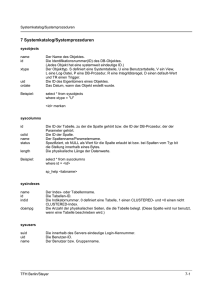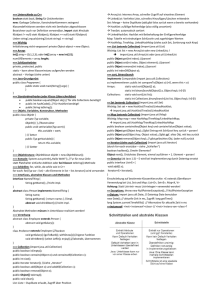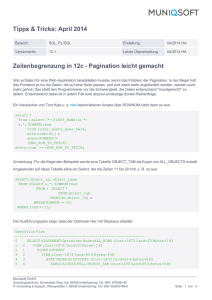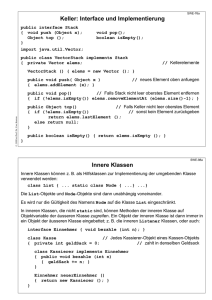in the Mapping of an Object Model to a - ETH E
Werbung
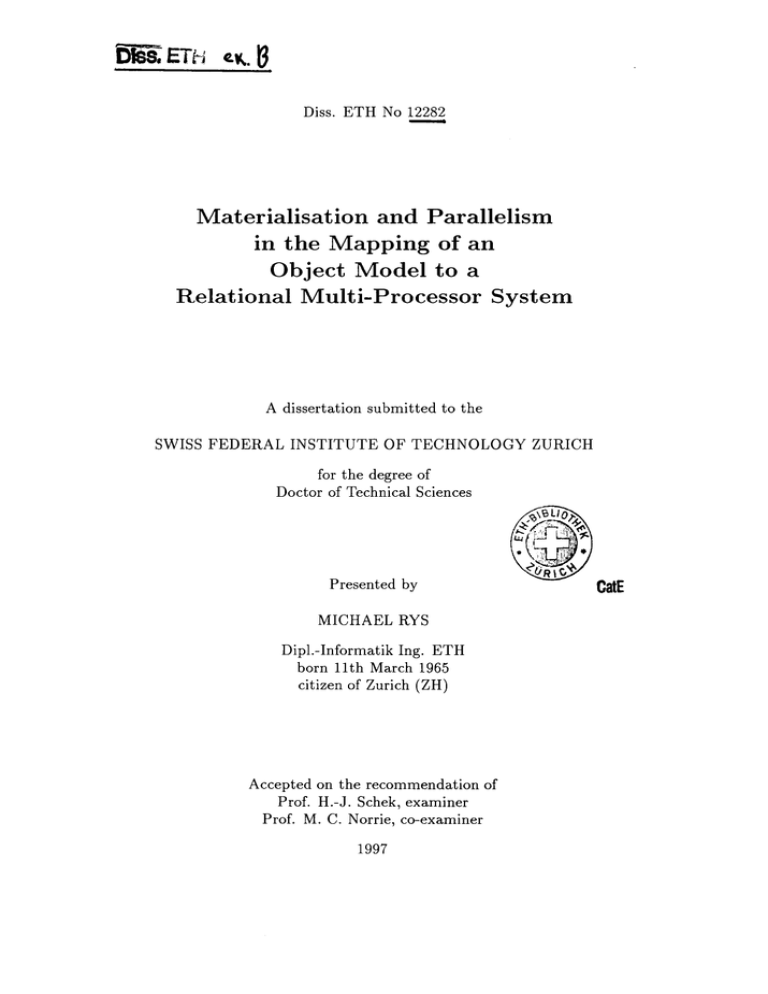
Diss. ETH No 12282 Materialisation and Parallelism in the Mapping Object of Model to an a Relational Multi-Processor System A dissertation submitted to the SWISS FEDERAL INSTITUTE OF TECHNOLOGY ZURICH for the degree of Doctor of Technical Sciences Presented by CatE MICHAEL RYS Dipl.-Informatik Ing. ETH born 11th March 1965 citizen of Zurich Accepted on (ZH) the recommendation of Prof. H.-J. Prof. M. C. Schek, examiner Norrie, co-examiner 1997 Abstract This dissertation introduces a sive power and of higher-order object manager which combines the expres¬ an object model with the efficiency provided by parallel extensibility database systems. By offering this efficient object model interface, the object man¬ ager provides its clients with the services necessary to build their complex application objects. In addition, the object manager takes advantage of the mature technology provided by commercial relational multi-processor database management systems by utilising them as "intelligent" storage servers and execution engines. Thus, the object manager functions as a coordinating middleware component which executes the highlevel object operations in parallel, hides the physical design on the relational level, and supports various execution guarantees in terms of modern transaction management. The dissertation the architectural issues of such object manager as well as the costs involved in the coordination. It discusses the mapping of the object model to the relational model and the translation of the high-level object operations to SQL. It fo¬ cuses on the aspect of employing materialisation and high-level parallelism for achieving high performance in term of response time and throughput. The investigates an of the object model to the relational level replicates the object properties and materialises the object groupings implicitly defined by the classification hierarchy. By using the replication and materialisation, the mapping separates the logical design on the object level from its physical design which is performed on the relational system's mapping logical level. Its primary aim is to achieve a significant response time improvement for the object level retrieve operations. Due to the replication of the object properties, the object recomposition costs of the standard object model mappings can be avoided and as a result of the class materialisation, partial answers are already pre-computed. In order to improve the performance of the update operations which have become in¬ creasingly complex due to the introduced materialisation and replication, parallelism is employed to maintain the object replicas. The dissertation develops efficient mainte¬ strategies based on the results of the relational view maintenance research and it decomposes the high-level update transactions into many small, parallelly executed rela¬ tional maintenance transactions. The application of multi-level transaction management guarantees the correctness of the update transactions and allows the transformation of the intra-transaction parallelism on the object manager level to the inter-transaction parallelism on the relational level. This transformation allows the utilisation of the nance in IV relational database's transaction manager for low-level vantage of the today's in the good support for the database systems update costs can provide. and it takes ad¬ The dissertation shows that a significant synthesis through transaction existing processing technology be achieved of multi-level transactions with parallel synchronisation execution of many small transactions which this reduction of research results in the area in relational database systems. investigation, the dissertation finally also identifies several requirements which should be fulfilled by an intelligent storage and execution server in order to effi¬ ciently support higher-order object managers. Based on the Zusammenfassung vorliegende Dissertation beschreibt ein semantisch hochstehendes Objektsystem, welches die Ausdrucksfahigkeit und Erweiterbarkeit eines Objektmodells mit der durch parallele Datenbanksysteme erreichbaren Effizienzsteigerung kombiniert. Das Objekt¬ system stellt seinen Klienten mittels dieser effizienten Objektmodell-Schnittstelle diejenigen Dienstleistungen zur Verfugung, die diese zur Herstellung ihrer komplexen Applikationsobjekte brauchen. Zusatzlich benutzt es bewahrte Datenbanktechnologie in Form eines relationalen Multiprozessor-Datenbanksystems als "intelligente" Speicherund Ausfiihrungskomponente. Dadurch wird das Objektsystem zu einer koordinierenden Middleware-Komponente, welche die Objektoperationen parallele ausfiihrt, den physischen Entwurf auf der relationalen Ebene abschirmt und verschiedene Ausfuhrungsgarantien beziiglich einer modernen Transaktionsverwaltung unterstiitzt. Die vorliegende Arbeit befafit sich sowohl mit den Architekturaspekten eines solchen Objektsystems wie auch mit den durch die Koordination entstehenden Kosten. Sie beschreibt die Abbildung des Objektmodells auf das relationale Modell und die Ubersetzung der Objektoperationen nach SQL. Sie konzentriert sich insbesondere auf die Anwendung von Materialisierung und Parallelitat auf einer hoheren Ebene, um eine hohe Leistung sowohl beziiglich Antwortzeit als auch Durchsatz zu erreichen. Die Abbildung des Objektmodells auf das relationale Modell repliziert die Objekteigenschaften und materialisiert die durch die Klassifikationshierarchie implizit definierten Objektgruppierungen. Dadurch trennt die Abbildung den logischen Entwurf auf der Objektebene vom physischen Entwurf, welcher auf der logischen Ebene des relationalen Systems durchgefiihrt wird. Das primare Ziel ist es, fur die Objektanfragen eine signifikante Verbesserung der Antwortzeiten zu erreichen. Dank der Replikation der Objekteigenschaften konnen die Objektrekonstruktionskosten herkommlicher Objektmodellabbildungen vermieden werden, und als Resultat der Klassenmaterialisierung sind TeilantDie worten schon im Voraus materialisiert. Um die durch die Materialisierung und Replikation komplex gewordenen Anderungsopeauszufiihren, werden die Wartungsoperationen der Objektreplika par¬ allel ausgefiihrt. Dazu werden, basierend auf den Forschungsergebnissen der relationalen Sichtenwartung, effiziente Wartungsstrategien entwickelt und die Anderungsoperationen der Objektebene in viele kleine, parallel auszufiihrende relationale Wartungsoperatio¬ Dabei garantiert der Einsatz des Mehrschichtentransaktionskonzeptes nen unterteilt. rationen effizient v VI Ausfiihrung der Anderungstransaktionen und erlaubt die Umsetzung der Intra-Transaktionsparallelitat auf der Objektebene in Inter-Transaktionsparallelitat auf der relationalen Ebene. Diese Transformation ermoglicht den Einsatz des relationalen Transaktionsverwalters zur tieferliegenden Synchronisation und profitiert von der, durch heutige Datenbanksysteme ausgezeichnet iinterstiitzten, parallelen Ausfiihrung vieler kleiner Transaktionen. Die vorliegende Arbeit zeigt, dafi mittels dieser Synthese von Forschungsergebnissen der Mehrschichtentransaktionsverwaltung und bestehender Transaktionstechnologie relationaler Datenbanksysteme signifikante Leistungssteigerungen der Anderungsoperationen erzielt werden konnen. die korrekte durchgefiihrten Untersuchungen identifiziert die Arbeit schliefilich Eigenschaften, die zukiinkftige intelligente Speicher- und Ausfuhrungskomponenten zur effizienten Unterstiitzung von semantisch hochstehenden Objektsystemen aufweisen soilBasierend auf den ten.
